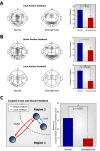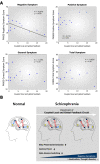Impaired coupling of local and global functional feedbacks underlies abnormal synchronization and negative symptoms of schizophrenia
- PMID: 23575114
- PMCID: PMC3639871
- DOI: 10.1186/1752-0509-7-30
Impaired coupling of local and global functional feedbacks underlies abnormal synchronization and negative symptoms of schizophrenia
Abstract
Background: Abnormal synchronization of brain oscillations is found to be associated with various core symptoms of schizophrenia. However, the underlying mechanism of this association remains yet to be elucidated.
Results: In this study, we found that coupled local and global feedback (CLGF) circuits in the cortical functional network are related to the abnormal synchronization and also correlated to the negative symptom of schizophrenia. Analysis of the magnetoencephalography data obtained from patients with chronic schizophrenia during rest revealed an increase in beta band synchronization and a reduction in gamma band power compared to healthy controls. Using a feedback identification method based on non-causal impulse responses, we constructed functional feedback networks and found that CLGF circuits were significantly reduced in schizophrenia. From computational analysis on the basis of the Wilson-Cowan model, we unraveled that the CLGF circuits are critically involved in the abnormal synchronization and the dynamical switching between beta and gamma bands power in schizophrenia. Moreover, we found that the abundance of CLGF circuits was negatively correlated with the development of negative symptoms of schizophrenia, suggesting that the negative symptom is closely related to the impairment of this circuit.
Conclusions: Our study implicates that patients with schizophrenia might have the impaired coupling of inter- and intra-regional functional feedbacks and that the CLGF circuit might serve as a critical bridge between abnormal synchronization and the negative symptoms of schizophrenia.
Figures




Similar articles
-
Reduced high and low frequency gamma synchronization in patients with chronic schizophrenia.Schizophr Res. 2011 Dec;133(1-3):99-105. doi: 10.1016/j.schres.2011.07.020. Epub 2011 Aug 16. Schizophr Res. 2011. PMID: 21849245
-
Whole-Brain Source-Reconstructed MEG-Data Reveal Reduced Long-Range Synchronization in Chronic Schizophrenia.eNeuro. 2017 Oct 17;4(5):ENEURO.0338-17.2017. doi: 10.1523/ENEURO.0338-17.2017. eCollection 2017 Sep-Oct. eNeuro. 2017. PMID: 29085902 Free PMC article.
-
Abnormal synchronization of functional and structural networks in schizophrenia.Brain Imaging Behav. 2020 Dec;14(6):2232-2241. doi: 10.1007/s11682-019-00175-8. Brain Imaging Behav. 2020. PMID: 31376115
-
Brain neural synchronization and functional coupling in Alzheimer's disease as revealed by resting state EEG rhythms.Int J Psychophysiol. 2016 May;103:88-102. doi: 10.1016/j.ijpsycho.2015.02.008. Epub 2015 Feb 7. Int J Psychophysiol. 2016. PMID: 25660305 Review.
-
Abnormal neural oscillations and synchrony in schizophrenia.Nat Rev Neurosci. 2010 Feb;11(2):100-13. doi: 10.1038/nrn2774. Nat Rev Neurosci. 2010. PMID: 20087360 Review.
Cited by
-
Envelope Following Response to 440 Hz Carrier Chirp-Modulated Tones Show Clinically Relevant Changes in Schizophrenia.Brain Sci. 2020 Dec 27;11(1):22. doi: 10.3390/brainsci11010022. Brain Sci. 2020. PMID: 33375449 Free PMC article.
-
Sleep electroencephalography and heart rate variability interdependence amongst healthy subjects and insomnia/schizophrenia patients.Med Biol Eng Comput. 2016 Jan;54(1):77-91. doi: 10.1007/s11517-015-1297-4. Epub 2015 Apr 19. Med Biol Eng Comput. 2016. PMID: 25894467
-
Exploration of Brain Connectivity during Human Inhibitory Control Using Inter-Trial Coherence.Sensors (Basel). 2020 Mar 19;20(6):1722. doi: 10.3390/s20061722. Sensors (Basel). 2020. PMID: 32204504 Free PMC article.
References
Publication types
MeSH terms
LinkOut - more resources
Full Text Sources
Other Literature Sources
Medical
Molecular Biology Databases

